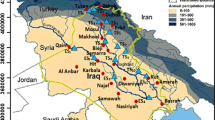Abstract
The relations of river morphology and tsunami propagation in rivers were studied at several rivers in the Tohoku region during The Great Chilean Tsunami of 2010 and The Great East Japan Tsunami of 2011. It was found that river mouth morphological features play an important role in the intrusion of low magnitude tsunamis in which the geological and geographical conditions are an important factor. Nevertheless, the effects of these features were not found in the case of an extreme tsunami wave. As the wave enters the river, the propagation depends on other factors. It was found that the intrusion distance correlates well to the riverbed slope. The measurements of water level and riverbed slope were analyzed to propose an empirical method for estimating the damping coefficient for the tsunami propagation in rivers based on the tsunami of 2011. The proposed empirical method was used to approximate the length of the tsunami intrusion into a river by assuming that the furthest distance is given for the ratio of local tsunami wave height to the tsunami wave height at the river entrance of 0.05 (5 %). The estimated intrusion length from the proposed method in this study shows a good comparison with measurement data.


















Similar content being viewed by others

References
Abe K (1986) Tsunami propagation in rivers of the Japanese Islands. Cont Shelf Res 5(6):655–677
Adityawan MB, Roh M, Tanaka H, Mano A, Udo K (2012a) Investigation of tsunami propagation characteristics in river and on land induced by The Great East Japan Earthquake 2011. J Earthq Tsunami 6(3):22. doi:10.1142/S1793431112500339
Adityawan MB, Roh M, Tanaka H, Farid M (2012b) The effect of river mouth morphological features on tsunami intrusion. Proceedings of The International Conference on Disaster Management: 75-83
Dalrymple RA (1992) Water wave propagation in jettied channels. Proceedings of 23rd Conference on Coastal Engineering: 3040-3053
Fritz HM, Petroff CM, Catalán PA, Cienfuegos R, Winckler P, Kalligeris N, Weiss R, Barrientos SE, Meneses G, Valderas-Bermejo C, Ebeling C, Papadopoulos A, Contreras M, Almar R, Dominguez JC, Synolakis CE (2011) Field survey of the 27 February 2010 Chile Tsunami. Pure Appl Geophys 168:1989–2010. doi:10.1007/s00024-011-0283-5
Hunt JN (1952) Viscous damping of waves over an inclined bed in a channel with finite width. La Houille Blanche 7:836–842
Mori N, Takahashi T, The 2011 Tohoku Earthquake Tsunami Joint Survey Group (2012) Nationwide post event survey and analysis of the 2011 Tohoku Earthquake Tsunami. Coast Eng J 54(1):27. doi:10.1142/S0578563412500015
Suppasri A, Koshimura S, Imai K, Mas E, Gokon H, Muhari A, Imamura F (2012) Damage characteristic and field survey of the 2011 Great East Japan Tsunami in Miyagi Prefecture. Coast Eng J 54(1):30. doi:10.1142/S0578563412500052
Tanaka H, Ishino K, Nawarathna B, Nakagawa H, Yano S, Yasuda H, Watanabe Y, Hasegawa K (2007) Field investigation of disasters in Sri Lankan rivers caused by the 2004 Indian Ocean Tsunami. J Hydrosci Hydraulic Eng 66:91–112
Tanaka H, Tinh NX, Dao NX (2011). Field measurement and numerical studies on the tsunami propagation into upstream of rivers. Proc. of 34th IAHR Congress: CD-ROM
Tanaka H, Nguyen XT, Umeda M, Hirao R, Pradjoko E, Mano A, Udo K (2012) Coastal and estuarine morphology changes induced the 2011 Great East Japan Earthquake Tsunami. Coastal Engineering Journal 54(1):25 pages. doi:10.1142/S0578563412500106
Tanaka H, Adityawan MB, Mano A (2014) Morphological changes at the nanakita river mouth after the Great East Japan Tsunami of 2011. Coast Eng 86:14–26
Tappin DR, Evans HM, Jordan CJ, Richmond B, Sugawara D, Goto K (2012) Coastal changes in the Sendai area from the impact of the 2011 Tōhoku-Oki Tsunami: Interpretations of time series satellite images, helicopter-borne video footage and field observations. Sediment Geol 282(30):151–174
Tsuji Y, Yanuma T, Murata I, Fujiwara C (1991) Tsunami ascending in rivers as an undular bore. Nat Hazards 4:257–266
Udo K, Sugawara D, Tanaka H, Imai K, Mano A (2012) impact of the 2011 Tohoku Earthquake and Tsunami on beach morphology along the Northern Sendai Coast. Coast Eng J 54(1):15. doi:10.1142/S057856341250009X
Viana-Baptista MA, Soares PM, Miranda JM, Luis JF (2006) Tsunami propagation along Tagus estuary (Lisbon, Portugal) preliminary results. Sci Tsunami Hazards 24(5):329–338
Yasuda H (2010) A one-dimensional study on propagation of tsunami wave in river channels. J Hydraul Eng 136(2):93–105
Yeh H, Titov V, Gusiakov V, Pelinovsky E, Khramushin V, Kaistrenko V (1995) The 1994 Shikotan earthquake tsunamis. Pure Appl Geophys 144(3–4):855–874
Yeh H, Tolkova E, Jay D, Talke S, Fritz H (2011) Tsunami hydrodynamics in the columbia river. J Disaster Res 7(5):604–608
Acknowledgements
The Ministry of Land, Infrastructure and Transport Tohoku district maintenance office and Miyagi Rivers Division provided the water level data and cross section in the rivers. The authors would like to thank the financial supports from Grant-in-Aid for Scientific Research from Japan Society for Promotion of Science (No. 2503364). This research was also funded by the Grant-in-Aid for Specific Research Project, International Research Institute of Disaster Science, Tohoku University, the Grant-in-Aid for Scientific Research from the River Environmental Fund (REF) in charge of the Foundation of River and Watershed Environmental Management (FOREM), and Assistance for Technological Development, Tohoku Construction Association.
Author information
Authors and Affiliations
Corresponding author
Additional information
Responsible Editor: Rodrigo Cienfuegos
This article is part of the Topical Collection on the 7th International Conference on Coastal Dynamics in Arcachon, France 24–28 June 2013
Rights and permissions
About this article
Cite this article
Tanaka, H., Kayane, K., Adityawan, M.B. et al. Study on the relation of river morphology and tsunami propagation in rivers. Ocean Dynamics 64, 1319–1332 (2014). https://doi.org/10.1007/s10236-014-0749-y
Received:
Accepted:
Published:
Issue Date:
DOI: https://doi.org/10.1007/s10236-014-0749-y



